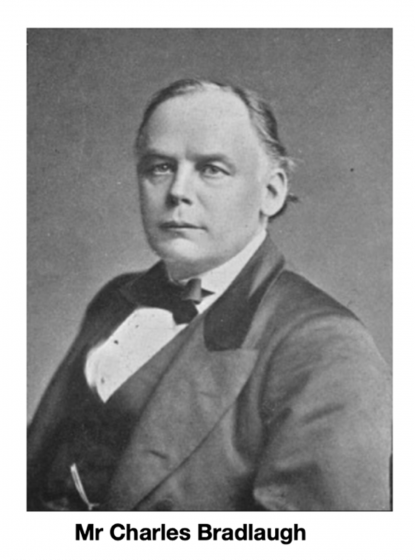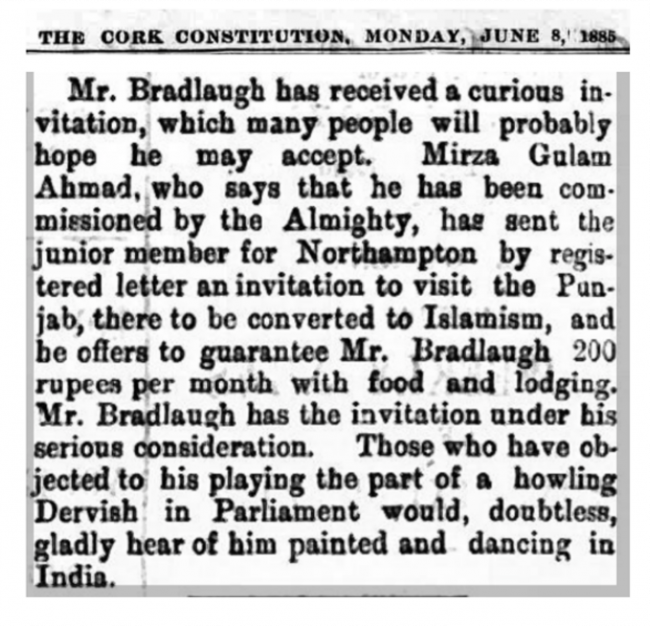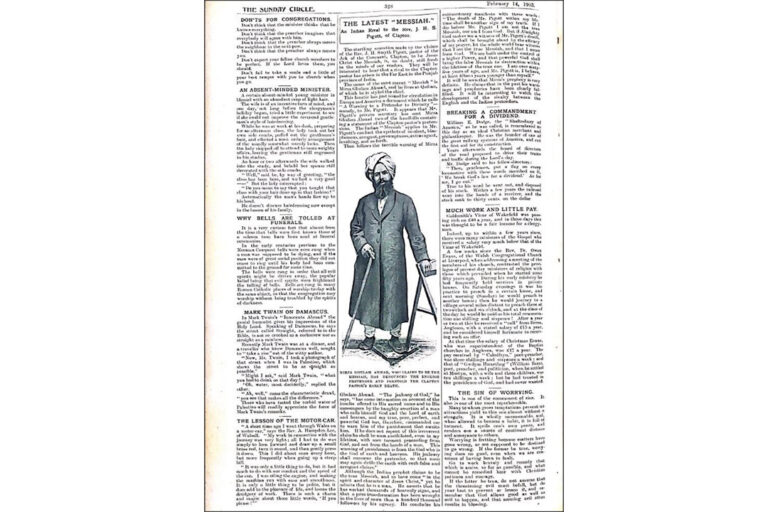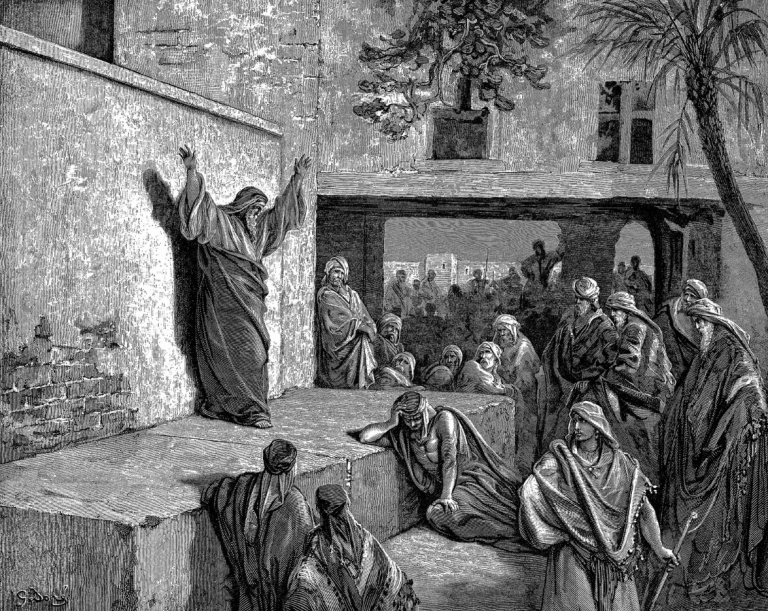The Promised Messiah’sas reply to the Christian and Hindu onslaught through articles in various magazines in defence of Islam , but it was his book, Braheen-e-Ahmadiyya that truly displayed the treasure of knowledge which God had bestowed him with. The first two parts of the book were published in 1880, the third was published in 1882 and the fourth in 1884. Further work on the book was then postponed as the Promised Messiah’sas attention was diverted from 1882 onwards to a much wider task. That year he was commissioned by God Almighty, through revelation, as the Reformer of the century.
In Braheen-e-Ahmadiyya Vol 1 the Promised Messiahas put forward a challenge to the follower of any religion that if on behalf of their faith they could present one-half, or one-fourth or even one-fifth of the excellences that he himself proposed to produce as the basis of Islam, then he would give the “one who duly responds to this challenge the possession and the right to make use of my property worth ten thousand rupees”.[1]
Barahin-e-Ahmadiyya at once halted the advance of all movements, like the Brahmu and the Aryah Samaj, and for a time, it paralysed the activities of all anti-Islamic forces. The Muslims of India had at last found that there was among them a champion of Islam, who had the determination and courage to demolish with conviction and logic, the attacks on Islam by various movements in India. The publication of this book came as a great shock to Christians and the Arya Samajists, who thought that Islam’s days of glory were over. The approach of the Promised Messiahas was so thorough that while defending Islam against all attacks, he demolished the very foundations and basis on which the Arya Samaj and the Christian movements were flourishing.
Barahin-e-Ahmadiyya, Part III records a dream which the Promised Messiahas saw in his early youth that is related to Barahin-e-Ahmadiyya. He writes:
“My humble self saw Hadrat Khatamul-Anbiya’ [the Seal of the Prophets], may peace and blessings of Allah be upon him, in a dream in 1864 or 1865 in my early youth, when I was still pursuing my studies. In my dream I had in my hand a religious book which I felt was of my own authorship. Upon seeing the book, the Holy Prophet, may peace and blessings of Allah be upon him, enquired from me in Arabic: ‘How have you named this book?’ I submitted: ‘I have named it Qutbi.’
The interpretation of this name has now come to my mind on the publication of this well-publicized book [Barahin-e-Ahmadiyya]—that it is a book, which, in its reasoning and arguments, is firm and unshakable like the polar star. Presenting the firmness of the contents of this book, I have issued a challenge and announced the award of a prize of 10,000 rupees [for any-one who might be able to refute it]. In short, the Holy Prophetsa took that book from me. The moment the blessed hands of the Holy Prophetsa touched it, it became an attractive and lovely fruit resembling a guava, but as large as a watermelon. When the Holy Prophetsa started cutting it into pieces to distribute it, it yielded so much honey that his blessed hand and forearm began to drip with it. Then a dead body that was lying outside the door came to life as a miracle of the Holy Prophetsa and came and stood behind me.
My humble self was standing before the Holy Prophetsa as a supplicant stands before a ruler. The Holy Prophetsa was occupying his chair in great glory and majesty, and with display of authority, as if he was a great champion. To summarize, the Holy Prophetsa handed over to me a piece of the fruit so that I might give it to the newly revived person, and he bestowed upon me all the remaining pieces. I gave that one piece to the revived person, which he ate immediately. When he finished eating it, I noticed that the blessed chair of the Holy Prophet, may peace and blessings of Allah be upon him, had risen much higher and the countenance of the Holy Prophet, may peace and blessings of Allah be upon him, began to shine forth like the rays of the sun, which was an indication of the revival and progress of Islam. While watching this display of light I woke up. [Allah be praised for all this.]”[2]
Many Muslim scholars and intellectuals wrote reviews of the book and considered it a great service to Islam, Muhammad Hussain Batalvi wrote a 200-page detailed review that was published in issues 6 to 11 of Ishat-u-Sunnah. He wrote:
“In our opinion, it is in this time and in the present circumstances, a book the like of which has not been written up to this time in Islam, and nothing can be said about the future; Allah may bring about another affair after this. Its author, too, has proved himself firm in helping the cause of Islam, with his property, his person, his pen, his tongue and his personal religious experience, to such an extent that it is rarely seen among Muslims who have gone before. If someone thinks that my words are Asian exaggeration, then show me at least one such book that confronts opponents of Islam especially the Arya Samaj with such gusto and enthusiasm. And point out such supporters of Islam who have taken upon themselves to help the cause of Islam with their property, their person, their treasure, their pen, and their tongue. And who has successfully challenged, with all his manly courage, opponents of Islam and deniers of revelation that if they doubt divine revelation to visit him and experience, observe and taste it.”[3]
The Appointed Time for the Promised Reformer
The Holy Prophetsaw is reported to have said الایات بعد المأتین i.e., the signs which will foresee the last day shall begin to be witnessed after two centuries.[4] The scholars have understood ال to signify one thousand years while مأتین means two hundred years. Thus, the hadith in its totality refers to the period of 1200 years after demise of the Holy Prophet. The advent of Messiah and Mahdi was understood to occur in the concluding years of the 13th century A.H. and at the beginning of the 14th century A.H. This is what the divines of the Ummah deduced from these traditions. Consequently, Nawab Siddiq Hasan Khan of Bhopal discussing the signs of the last days stated in his book written at the close of the 13th century:
“And at the head of the fourteenth century to which there are still ten more years to go, if the advent of Mahdi and the descent of Jesus takes place, they will be the Mujaddid and Mujtahid.”[5]
“Some holy saints and learned theologians have said that the advent of the Mahdi shall take place after 1,200A.H., and in no case it shall step beyond 1,300 A,H…..Ninety years of the present century, which is the thirteenth century of the Muhammadan era have passed, but the Mahdi has not yet made his appearance, and one is inclined to think that the Mahdi may make his appearance at the head of the 14th century”.[6]
Similarly, Nawab Nurul Hasan, the son of Nawab Siddiq Hasan Khan, in his book Iqtarabus Sa’at, written at the beginning of the 14th century, stated on page 221:
“In accordance with this calculation the Mahdi should have appeared in the 13th century, but the century elapsed and the Mahdi has not come. Now we are almost in the 14th century and even six months have passed of it since this book was written. Probably God will favour us with His Grace, Equity, Mercy and Generosity; and the Mahdi may appear within four to six years.”[7]
Although the Promised Messiahas was a recipient of divine revelation and dreams from the time of his youth, it was in 1882, at the beginning of the 14th century that the Promised Messiahas received revelations indicating the station of Mujaddidiyat and he met the Holy Prophetsa in a dream. The Holy Prophetsa embraced him, and he saw that rays of light proceeded from his countenance and entered into him. He felt these rays were like palpable light which was not only experienced through his spiritual sight but also with his physical eyes.[8]
The Promised Messiahas wrote: As the 13th century of the Hejira drew to a close and the beginning of the 14th century approached, I was informed by God Almighty, through revelation, that I was the Mujaddid (Reformer) for the 14th century and I received the revelation:
الرحمن علم القران۔ لتنذر قوما ما انذر اباؤھم ولتستبین سبیل المجرمین قل انی امرت وانا اول المؤمنین
The Most Gracious One has taught you the Qur’an so that you should warn the people whose ancestors have not been warned, and that the way of the guilty ones might become manifest. I am the first of the believers.[9]
The lengthy revelation, which begins with “Allah has placed blessing in you, O Ahmad” was published in the first volume of Braheen-e-Ahmadiyya. In the third volume of the Braheen-e-Ahmadiyya the Promised Messiahas presented himself as a criterion to judge the truthfulness of a living religion (Islam) by asking the seekers to come to Qadian to witness a sign for the truthfulness of Islam. It was the first time that someone had put forward an alternative criterion to judge the truthfulness of a religion. Until then, the focus of all faiths had been on rational and narrative reasoning.
He writes: “Those who obey the Holy Quran and wholeheartedly believe in God’s beloved Prophet, love him, and consider him better and holier and more perfect and most excellent and superior than the whole of creation, all Prophets, Messengers, all holy ones, and all that has ever existed or shall exist, they continue to partake of those bounties and they drink and continue to drink copiously, pleasantly and deliciously the same drink that was given to Musa [Moses] and Isa [ Jesus] to drink. They are illuminated with the light of Israel and enjoy the blessings of the Prophets who were descendants of Ya‘qub [ Jacob]. Subhanallah [Holy is Allah], again subhanallah. How high is the station of Hadrat Khatamul-Anbiya’ [the Seal of the Prophets], peace and blessings of Allah be upon him. Glory be to Allah. How magnificent is the light that his modest servants, lowest followers and humblest helpers attain the above-mentioned ranks……..The Christian priests, as well as the Pundits, Brahmus, Aryas and other opponents of our time need not feel bewildered and ask where are the blessings and the heavenly light of which the blessed followers of Hadrat Khatamul-Anbiya’, peace and blessings of Allah be upon him, share with Musa and ‘Isa and where is the heritage of the light from which all other people and followers of other nations and religions are deprived and debarred. To set this doubt at rest, I have stated several times in this very foot-note that I am responsible for providing such a religious proof to any seeker after truth who is prepared to readily enter the fold of Islam after having witnessed the excellences peculiar to Islam.”[10]
He further writes: “Even today a seeker can experience the spiritual blessings that ought to be experienced by sincere followers of the True Faith and the Divine Scripture and can partake of special divine mysteries. Anyone who wishes to experience these blessings should come forward with honest intentions and he will witness them and come to an auspicious end; and, God-willing, every seeker after truth will find his goal and every man of insight will bear witness to the glory of this Faith.”[11]
It seemed as if the announcement had fallen on deaf ears, and no one came forward to accept his proposal. But the opposition was mainly from Arya Samaj and the Christian priests. A section of Muslim scholars regarded the revelations of the Promised Messiahas as heretical because many of them contained Quranic verses. However, some among the Muslim clerics considered him a champion of Islam. Muhammad Hussain Batalvi defended the revelations of the Promised Messiahas in the issues of Ishat tu sunnah, declaring them to be as spiritual proofs of the truthfulness of Islam. He wrote:
“The author of Braheen Ahmadiyya, according to the testimony of friends and foes, regulates his life according to the law of Islam and is a pious and truthful person. It is well known that Satanic suggestions are mostly false but not one of the revelations received by the author of Braheen Ahmadiyya has been proved false up to this day. not, therefore, be considered Satanic suggestions. Can any Muslim follower of the Quran believe that Satan can be given knowledge, like the Prophets and the angels, of that which is hidden so that not one of his disclosures of the hidden should lack truth ?”[12]
Similarly, The Riad-e-Hind of Amritsar, a non-Muslim paper, published the following comments in its issue of March 1, 1886:
“The excellent merits and high spiritual accomplishments of Mirza Sahib are too great for our humble observations in our journal. The cogent reasons and the brilliant arguments that he has brought forth in support of Islam and truth, in so beautiful a manner, show beyond doubt that he has excelled the writings of the old and the new ulema (scholars) in eloquence and presentation. Those who have read his work, the Barahin-e-Ahmadiyyah, will surely agree with us in saying that although the book was published several years ago and a prize of Rs.10,000 was offered in printed leaflets for its refutation, the opponents of Islam and the Holy Prophet(saw) have not had the courage to come forward and claim the prize.”
In 1885 The Promised Messiahas announced that he was the Promised Reformer for the 14th century. This announcement was published in Urdu and translated into English. Eight thousand copies were sent as registered letters to the religious leaders, rulers, scholars, judges and theorists in Asia, Europe, America and wherever it was possible to be sent by post. The announcement invited representatives of religions and other prominent members of society to come and witness the truthfulness of Islam at Qadian.

If a sign was not witnessed within a year, a sum of two hundred rupees per month, two thousand four hundred rupees for a year would be paid as compensation to such an individual.[13] Among the receipts of this announcement, the head of the Theosophical Society Henry Steel Olcott, although declined the offer but he published two circulars of the Promised Messiahas in the September issue of his journal ‘The Theosophist’.[14]
Similar example of this invitation is found in Cork Constitution an Ireland based newspaper as part of their London correspondence section. Mr Charles Bradlaugh was a political activist and atheist who found the National Secular Society in 1866, at the time of receiving this invitation from the Promised Messiahas he was serving as the liberal MP of Northampton. The Cork Constitution, Monday, June 8, 1885, reports:
“Mr Bradlaugh has received a curious invitation, which many people will probably hope he may accept, Mirza Gulam Ahmad who says that he has been commissioned by the Almighty, has sent the junior member for Northampton by registered letter an invitation to visit the Punjab, there to be converted to Islamism, and be offers to guarantee Mr. Bradlaugh 200 rupees per month with food and lodging. Mr. Bradlaugh has the invitation under his serious consideration.”
This may have appeared as a strange proposal especially when the followers of all faiths based their beliefs upon tales and stories of the past as opposed to a direct experience. By the year 1891 twenty thousand such leaflets were published establishing the superiority of Islam.
The Promised Messiahas writes in Fath-e-Islam (The Victory of Islam):
“A second branch of this work is concerned with the publication of leaflets which, also under divine command and for satisfaction and conviction of all concerned, has already been undertaken. More than 20,000 leaflets on Islamic truths and arguments have been published. The process is continuing according to need in the future.”[15]
He further writes: “Similarly, 20,000 leaflets in English and Urdu were printed, add to these more than 12,000 leaders of hostile groups were sent these by registered post and there was not a single priest in India to whom this announcement was not sent by registered mail. Moreover, people in Europe and America were also sent these announcements through registered mail to complete the effort/argument. Is it not a wonder that with only very meagre means this huge work goes on?”[16]
In 1891 the Promised Messiahas published three books, Fath-e-Islam(The Victory of Islam), Taudih-e-Maram (Elucidation of Objectives) and Izala-e-Auham (The Removal of Misconceptions). In these books, he claimed to be the Promised Messiah and denounced the ascension and the descent of Jesusas by proving his demise.
“I have a special resemblance to Jesus, on account of which I have been sent with his name so that I should demolish the doctrine of the Cross. I have been sent to break the Cross and to slaughter the swine. I have descended from heaven with angels on my right and left whom God, Who is ever with me, will cause to enter, and indeed is already causing to enter, into every eager heart for the achievement of my purpose. Even if I were to remain silent and my pen were to refrain from writing, the angels that have descended with me would not stop their function. They have been furnished with powerful maces with which to break the Cross and to demolish the temple of the worship of creatures[17] This announcement by the Promised Messiahas was opposed from all directions, even those from Ahle Hadith who had previously supported him. Muhammad Hussain Batalvi, who had earlier highly commended Braheen-e-Ahmadiyya, travelled across India to collect signatures for an edict of disbelief, which he prepared against the Promised Messiah(as). He thought that it was due to his support that the Promised Messiahas had achieved such prominence and he assumed that his opposition would be a source of the Promised Messiah’sas defamation. How deluded he was! His name is now no more than a footnote that only comes up with reference to the Promised Messiah(as).
When the Promised Messiahas and Mahdi failed to appear in the 14th century in accordance with the interpretations of the Muslim clergy, in despair some turned to the view that the 14th century will continue to the end of times, until the coming of the Messiah and Mahdi, others claimed that the Mahdi in fact was not going to come. Some examples of the second opinion are: Nawab Noor Hassan son of Nawab Siddiq Hassan wrote:“We admit that Mahdi may not come. This does not contradict any important belief of the people of Islam.”[18]
Allama Iqbal, in one of his couplets, writes: “Witness the manifestation of the glory of thy Lord, in the lofty state of your heart. Abandon all hope of the advent of the Mahdi and Jesus”[19]
At another place he writes: “In my opinion, traditions pertaining to the advent of Mahdi, Second Coming of Messiah, and the appearance of Mujaddids, owe their origin to the Iranian and non-Arab way of thinking. They have nothing to do with the Arab concepts or the true spirit of the Holy Qur’an.[20]
Shorash Kashmiri, the leader of Majlis-e-Ahrar, in his weekly magazine “Chattan,” wrote:
“As far as the belief for the Promised Messiah is concerned, it is the invention of the helpless and the indolent.”[21]
[1] Barahin-e-Ahmadiyya, Part 1 P.49
[2] (Barahin-e-Ahmadiyya, Part 3, Ruhani Khaza’in, vol. 1, p. 274–276 sub-footnote no. 1, see also, Tadhkirah, 2nd English edn., p. 5–6)
[3] Isha‘atus-Sunnah (Vol. 7, Nos. 6-11).
[4] Mazahir-e-Haq, Mishkat-ul-Masaabih Vol 5 P.53 (Chapter III Section III Hadith 5460: The Signs of the last hour) / Sunan Ibn Maja hadith 4057
[5] Hujajul Karamah, p. 135-139
[6] Hujaj-ul Karamah P.394-395
[7] Iqtarabus Sa’at, P. 221
[8] TADHKIRAH P. 55-56
[9] Kitabul-Bariyyah, p. 168, Ruhani Khaza’in, vol. 13, p. 201
[10] BarĀhĪn-e-aHmadiyya — Part three P.175-176
[11] BarĀhĪn-e-aHmadiyya — Part three P.228-229
[12] IshaatasSunnah Vol 7 No 6-11/ Translation from Ahmadiyyat the Renaissance of Islam by Hazrat Ch. Zafarullah Khanra p.28
[13] Majmua Ishtiharat Vol 1 P.20-22/Ruhani Khazaen Vol 6 Shahada-tul-Quran P.
[14] This is further discussed in detail in the chapter 4 of this volume.
[15] Ruhani-Khazain Vol 03 Fath-e-Islam P.13
[16] Ruhani-Khazain Vol 03 Fath-e-Islam P.29
[17] Fathe Islam, p. 17 footnote, Ruhani Khaza’in, vol. 3, p. 11 footnote
[18] Iqtarabus Sa’ah, p. 147
[19] Baqiyat-e-Iqbal, by ‘Abdul-Wahid Mu‘ini, p. 451, published in Lahore
[20] Iqbal Namah, vol. 2, p. 230–231, Letter addressed to Chaudhry Muhammad Ahsan)
[21] Shorash Kashmiri, Chitan, Lahore, May 28, 1962




Mashallah